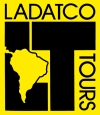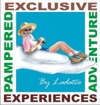

Destinations
Experiences
 |
L A
D A T C O T O U R
S |
 |
||||||||
| HOME | South America | Falkland Islands | Antarctica | Unique Destinations |
Unique Experiences |
Newsstand | ||||
|
Paraguay General
Information |
|
PARAGUAY AT A GLANCE - Courtesy of InterTours:
A landlocked country located between latitude 19º and
27º south and longitude 54º and 72º west of Greenwich. The Tropic of Capricorn crosses
the country, and has a total area of 406,752 km2. The Paraguay River divides the country
into two regions:
WESTERN PARAGUAY, also known as EL CHACO, a vast flatland divided into two areas: Alto and
Bajo Chaco or upper and lower Chaco.
ALTO CHACO is slightly higher than the Bajo Chaco and it is recognized by its savannas and
natural ponds surrounded by forests and thorny scrub vegetation. The Bajo Chaco is
bordered by the Paraguay and Pilcomayo Rivers; it is almost at sea level and is covered by
endless palm forests.
The majority of people in the Chaco live in the Bajo Chaco region because of the climate,
the rain calendar and type of soil, and in the colonies established in the Central Chaco
region. The wild Chaco has less than one inhabitant per square kilometer.
EASTERN PARAGUAY appears for the visitor with completely different topography. It has
tropical and semitropical forests, interrupted by natural grasslands and small hills with
a maximum height of 850 meters. Its elevation slowly rises towards the Brazilian border
and is crisscrossed by numerous rivers. There are two large lakes called the Lake Ypoa and
the well-known Lake Ypacarai. It is the most populated region in the country and where the
main cities are located.
RIVERS
The PARANA and PARAGUAY are the largest and most important waterways, both of which
originate in Brazil. The Parana River is approximately 4,500 km long and its flow is
interrupted by the largest hydroelectric dam in the world —Itaipu— located in
the Iguassu Falls area, on the border with Brazil. Another hydroelectric dam situated on
the same river, but on the border common with Argentina is the Yacyretá Dam. The Parana
and Paraguay Rivers run into the Rio de la Plata or River Plate delta and flow into the
Atlantic Ocean off the coast of Uruguay.
The Paraguay River, which is 2,600 km long, is navigable for almost its entire course,
from north to south. The Pilcomayo River has its source in the Bolivian Andes, winding
southwest until it discharges into the Paraguay River. The Pilcomayo creates a natural
border with Argentina, to the west. Other major rivers are Tebicuary, which is only 235 km
long and ends when it meets the Paraguay River, and the Confuso River runs almost parallel
to the Pilcomayo and is 280 km long.
MOUNTAIN RANGES
There are several mountain ranges of considerable importance located in the eastern
portion of Paraguay:
- Cordillera del Amambay has its highest peak measuring 700 meters, and is located in the
Cerro Corá National Park in Pedro Juan Caballero.
- Cordillera de Mbaracayu runs some 120 km. in length and is a natural border between
Paraguay and Brazil.
- Cordillera de Caaguazu is located in the middle of the country, close to the Ybytyruzu
mountain range.
- The towns of Altos, Caacupe, Piribebuy, and Paraguari are all located in Cordillera de
Altos. These towns are of importance because of their contribution to handmade crafts
and/or to the history of the country.
- La Colmena, La Rosada (old iron foundry), and Parque Nacional Ybycui are located within
the Cordillera de Altos.
FLORA
Undoubtedly the most important and longest-lasting impression one gets from a visit
to Paraguay is the explosion of colors caused by the native flora seen in the countryside
or in the City of Asunción. A humid forest covers a large part of the country and the
most common trees are:
- Lapacho Rosado, the national tree that blooms during the winter.
- the Yellow Ybyrapyta, which blooms during the summer and fall.
- Petereby and Guaycá.
- The blue Jacaranda and the red flamboyant complete this symphony of colors in the
springtime.
- Flowers such as jasmine, the white and orange blossoms of the mango trees, hibiscus,
acacias and orchids are common in Paraguay, giving a natural wildlife aroma.
Yerba mate is a native shrub that grows in the wild. Its green leaves are dried and
crushed to prepare the traditional tereré, a beverage prepared with cold water in the
summer and mate, with boiling water during the winter.
FAUNA
Paraguayan fauna is concentrated in the savannas and semitropical areas. It is best
to mention only the most common species, as the list is never-ending:
- Mammals: wild hog, white-collared peccary, tapir, puma or American lion, jaguar, coati,
armadillo and Cappuccino monkey.
- Fish: Surubi, dorado, pacu.
FOLKLORE AND TRADITIONS
Music
Polcas and Guaranias are the most popular music styles of Paraguayan folklore.
The polca, with its short and quick waltz steps has nothing to do with the European polka.
Among the traditional dances, the Santa Fe, Galopera and Danza de la Botella (“Bottle
Dance”) are favorites. Guaranias are the slow romantic rhythms usually used to
serenade ladies. The typical Paraguayan “conjunto” consists of one Paraguayan
harp (36 strings without pedal) and two Spanish guitars.
Handcrafts
Native Indian ancestors and the legacy left by the Spaniards provide for a very
interesting and diverse collection of arts and crafts. The following is a sampling of what
Paraguay has to offer: Ñanduti: lace fashioned after a spider’s web, found in
Itaugua; Ao Po’i: fine embroidery found in the village of Yataity. Encaje ju:
miniature needlepoint lace found in Piribebuy; La Gallinita: Paraguayan lucky charm, a
small ceramic hen found in Itá and Areguá; Filigree: gold and silver filigree jewelry
and the famous Paraguayan seven-band ring (Carretón de Siete Ramales) are found in Luque.
Paraguayan Harps and Guitars: found in Ypacarai and Luque. Sombrero Pirí: Typical straw
hat made in the City of Limpio. Finished Leather Goods: All kinds of embossed leather
goods and furniture can be found in Tobatí and Ypacaraí. Wood Sculptures: Finely carved
and detailed wood sculptures can be found in Asunción, Concepción and Tobatí. Indian
Handicrafts: Plates, bows and arrows, belts, waistbands, bead necklaces, and bags made by
natives can be found in abundance in Asunción and Filadelfia.
Cusine
Sirloin tips, ribs, tenderloin and steaks, chicken, pork, lamb, and fish are the most
popular ingredients to prepare a Paraguayan asado or barbecue outdoors. Spicy sausages,
Sopa Paraguaya a cornbread pie with cheese and onion, in addition to mandioca (manioc or
yucca root) and the ever present mixed salads are the usual dishes accompanying any asado
(barbecue). Other traditional delicacies are soyo: a meat and vegetable soup; bori bori: a
soup containing little balls of cornbread and cheese; chipa: bread made from corn flour,
manioc starch and Paraguayan cheese; chipa so'o: chipa with a spicy ground beef filling;
empanadas: A fried or baked pastry shell filled with ground beef, chicken, heart of palm,
or ham and cheese.
On a typical hot and humid summer day, you will find the locals drinking tereré (cold
herbal tea) out of a cup usually fashioned from wood or a cow’s horn (guampa) with a
silver or brass straw (bombilla) that has a filter at the tip. This tea is made out of
yerba mate, which is complemented with additional medicinal herbs called yuyos, which give
the beverage flavor.
During the winter, they drink the same tea but the water is hot and the beverage is sipped
slowly through the metal straw from a gourd-like cup (ka’a-y-gua) smaller than the
guampa. Cocido is another traditional concoction made with burnt sugar and yerba mate